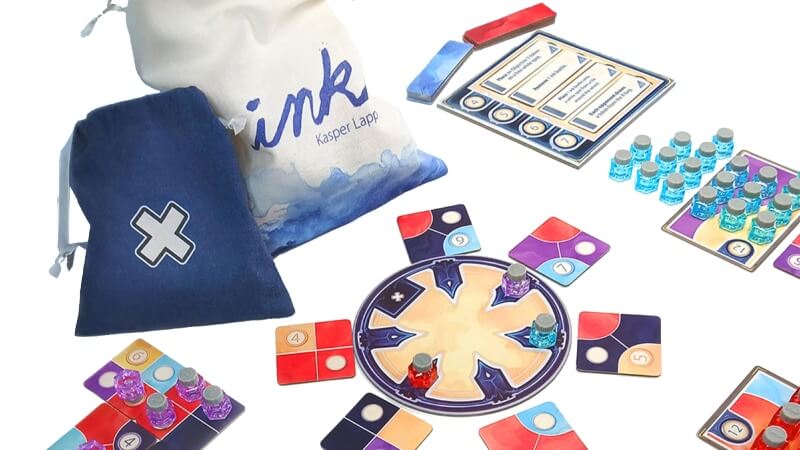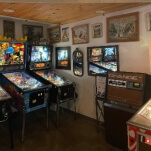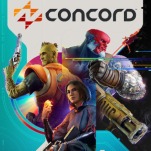Designer Kasper Lapp had a massive hit with his silent cooperative game Magic Maze, which was a Spiel des Jahres finalist in 2017 and spawned several spinoffs versions, including the more challenging Magic Maze Tower (no time limit, but bigger levels and harder puzzles). I tend to follow the work of designers whose games I like, so I tried some of Lapp’s designs post-Magic Maze, but he hasn’t had anything close to that one, and I assumed he’d be a one-hit wonder—not that there’s anything wrong with that given how hard it is to have even one game break through in this industry.
His newest game, Ink, may not be as good as Magic Maze, but this is clearly Lapp’s best game since then. It’s a competitive game of tile-laying and pattern-building with extremely simple rules that ends up a challenge in two ways: trying to set yourself up to make big moves later in the game, and trying to ensure you get the tiles you need while maybe taking something your opponents do.
In Ink, the tiles are all square-ish, with four squares* on them in two to four colors, with five total colors in the game. Some squares have white circles on them; some of those white circles show a number from three to seven. Each player starts with one of those tiles, with four different colors. There’s a rondel that goes in the middle of the table, with six more tiles randomly drawn from the bag placed around it, and a seventh space with an X on it in between two of those tiles. Each player starts the game with 24 ink bottles, 12 for their two focus colors and 12 for any color. Players begin with their tokens on the X, and then may move as many spaces as they want around the rondel, taking the tile where their token lands.
*: Some of those tiles aren’t divided into squares, so that the spaces on opposite corners are connected through the middle. I’m going to call them squares for simplicity and because I’m not a pedant.
When you take a tile, you can orient it any way you want, or flip it to the reverse site, and then place it anywhere on your tableau, as long as it’s touching an existing tile by at least half of an edge (the length of one of those squares on the tile). Those numbers on some of the tiles are objectives, and if you include one of them in a chain of contiguous squares of the same color with that number of squares in it, you can claim the objective. You take ink bottles from your supply and place them on any empty white circles in that chain, and if the objective you fulfilled had a four or higher value, you also get to take a bonus action based on which ones you chose for that game. If that chain is one of your two focus colors, they come from that first set of 12 bottles, which you can’t use on any of the other three colors, so the game requires you to build at least some chains in those colors.

Every time you get back to that starting X on the rondel, you have to take a two-square tile that blocks spaces on your tableau. The X tile will have one or two colors on it, and you must cover at least one square matching one of those colors. If you cover an empty white circle, it’s gone for the rest of the game; if you cover one with an ink bottle on it, the bottle goes back to your supply.
As I write this out, it sounds a lot more complicated on the page than it does on the table. You move around the rondel, take a tile, place it. If you made a chain big enough to match a numbered circle in the chain, place ink bottles on all the white spaces in the chain. When you go around the entire rondel, take an X tile and cover part of your tableau. You may get some bonus actions.
The game ends when any player places their last ink bottle; if they can place even more, they can take extra black bottles from the common supply and place them, which forms the game’s tiebreaker. Game length varies, but it’s under an hour once you know the rules.
The bonus actions are key to making Ink something different, and giving it any real replay value. There’s a set of starter bonus actions, and within them, the 7 action is turbo-charged: draw a random tile from the bag and place it. At worst, you get a tile that just doesn’t help you right now. At best, it fits something you were already building, and you can claim multiple objectives in a single turn—or set up your next 7-square chain. You can choose specific bonus action tiles, or choose them randomly from the 12 (two sets of six, weaker and stronger) that come in the box.
Ink garners many comparisons to a Uwe Rosenberg game published in at least four versions, probably best known as Nova Luna, although I think Sagani is the best iteration. Those games, like Ink, ask players to draft and place tiles to create chains to complete patterns. The Rosenberg games work around a punitive scoring metric, where you gain points for finishing patterns but can lose points, often quickly, if you can’t finish something, or have too many incomplete patterns on your tableau at once. Ink hits players with a penalty when they move a full circuit around the rondel, but it’s more of a tax than a penalty, so this game has a more casual vibe to it, and there’s none of the tension of running out of token.
Ink does include special player tokens that the rules say are for use if any player is color-blind, but I don’t understand how a color-blind player could distinguish the five colors on the actual ink tiles—they’re distinct enough for someone with full color vision, but there are no patterns or other symbols that I could see to help anyone else. It seems like an easy thing to address just by creating one unique symbol for each color and putting it on the tiles.
Players who haven’t played the Nova Luna/Sagani games will probably enjoy Ink quite a bit, as it’s a simple game to learn (the rule book is only four pages, not counting solo mode) and the actual game play is sufficiently challenging. I wouldn’t take it over Sagani, and I’m not sure that I need both of those games in my library, but that’s a very specific bias that most gamers probably won’t face. Here’s hoping a future printing makes the game a little more accessible.








































